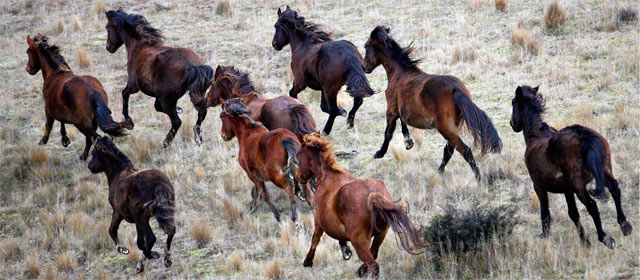He korero whakarapopoto
First horses in New Zealand
The first horses were brought to New Zealand by the missionary Samuel Marsden in 1814. Māori, who hadn’t seen horses before, were amazed by these large animals. They realised the usefulness of horses, and quickly began using them.
In 1911 there were 404,284 horses in New Zealand, the highest number ever. By 2004 there were only 76,918.
Types of horses
Draught horses are large and strong. They were used for heavy work such as pulling ploughs. Scottish Clydesdales were the most popular.
Lighter horses, which were used for riding and pulling carriages, included:
- Hackneys
- Cleveland Bays
- Arabians
- Thoroughbreds
- Standardbreds.
Some American breeds that have become popular horses for sport are:
- Palominos
- Appaloosas
- Quarter horses.
Ponies are smaller than horses, and are usually more heavily built. Two popular types are Shetland and Welsh ponies.
Transport
Before cars and trucks, horses were the most important form of transport. Riding horses helped people to travel faster, and they could carry supplies on packhorses.
Horse-drawn vehicles included:
- wagons and carts, used for carrying goods
- carriages and coaches, for transporting people
- buses and trams, in cities.
Horses and farming
Before tractors, horses were used to pull ploughs and machines for harvesting crops. They were hitched to carts for transporting crops and wool bales, and bringing supplies back from town. Working horses needed to be looked after well, and one horse ate about as much as eight men.
Packhorses were used to take food and supplies to remote parts of high country stations. They are still sometimes used to help muster stock, especially on large farms.
Women and horses
Until about 1900, women usually rode side saddle, wearing long flowing skirts. Later, they rode astride and wore divided skirts or trousers. Māori women were often keen riders, and there were special ‘wahines’ horse races.
Horses and war
Horses were used in the New Zealand wars of the 19th century. New Zealand troops took horses with them to the South African War and the First World War. Horses were used by cavalry (mounted soldiers) and for pulling heavy guns and equipment.
A herd of wild horses live in the Kaimanawa Mountains of the central North Island. They are thought to have come from horses that were set free, or escaped from farms or the military.
Horses and sport
Many New Zealanders enjoy horse sports, including:
- racing, including trotting and pacing
- equestrian sports such as show jumping
- hunting
- polo
- rodeo.
There are many pony clubs for young riders.





